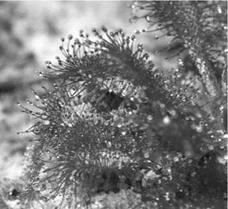Whilst all of the above examples are from the animal world, adhesion is also used by many plant species to fulfill diverse functions. For example, it is strongly involved in mechanisms for the dispersal ofseeds and fruits. Typically, adhesive fruits attach to a passing animal and are carried until they drop off, or the animal detects and removes them. There are two distinct attachment mechanisms found in plants: mechanical interlock or hooking (84%); and gluing of viscid fruits (13%) [118]. Among viscid fruits, three main types can be recognized:
• fruits that become sticky only when wet
• tarry fruits
• fruits with hairs that do not need moisture to become sticky
Diaspores can be viscid in five ways: sticky cuticle (calyces); viscid (glandular) hairs (bracts); viscid seed bodies; viscid drupes/berries; and viscid diaspores with drupes.
The sticky diaspores may be dispersed in three ways. First, the seeds may be attached to the plumage ofbirds consuming the fruit pulp. Second, sticky seeds may be carried on the feathers after they have passed through the gut of a frugivorous bird. Third, the seeds remain sticky for up to 10 min after fruit explosion and can attach to birds foraging in the vicinity. Adhesion, based on sticky secretions, is used by many plants to seal damages, or by carnivorous plants to catch insects (Figure 8.88).
|
Figure 8.88 Carnivorous plant spoon-leaf sundew Drosera spatulata with sticky hairs covered with adhesive secretion used fortrapping insects. The insects are digested and used as additional nutrients for plants growing on poor soils. |
The adhesive properties as well as chemical composition of plant glues require further investigation.
8.16.5
 19 января, 2016
19 января, 2016  Pokraskin
Pokraskin 
 Опубликовано в рубрике
Опубликовано в рубрике 